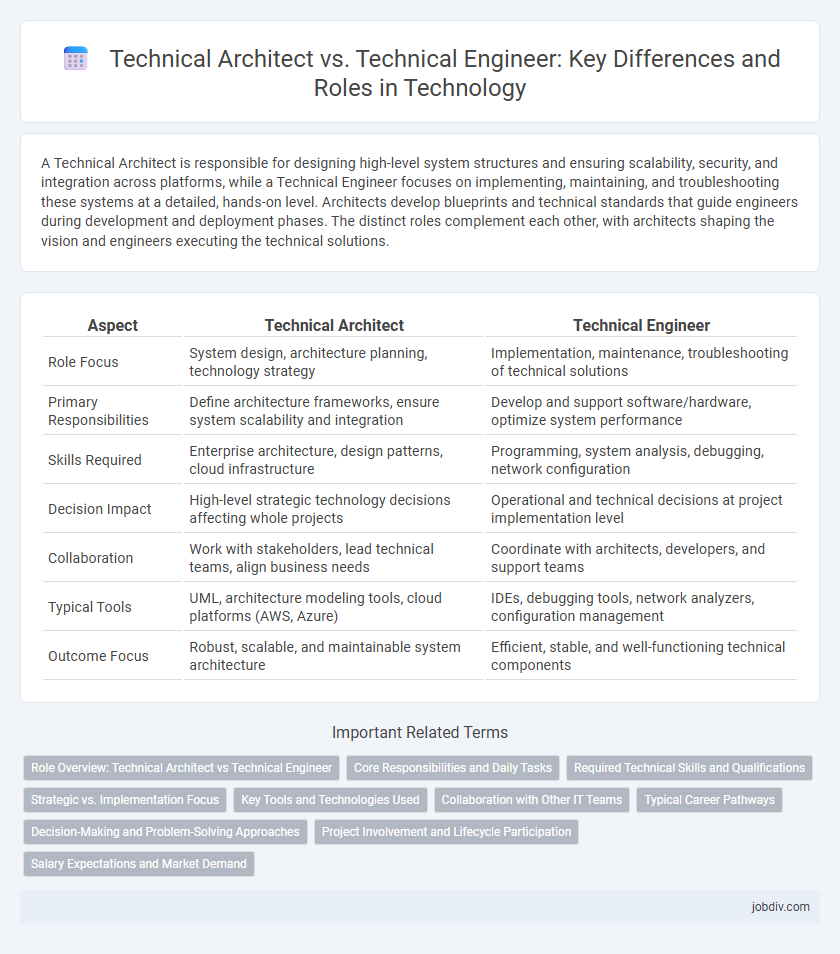A Technical Architect is responsible for designing high-level system structures and ensuring scalability, security, and integration across platforms, while a Technical Engineer focuses on implementing, maintaining, and troubleshooting these systems at a detailed, hands-on level. Architects develop blueprints and technical standards that guide engineers during development and deployment phases. The distinct roles complement each other, with architects shaping the vision and engineers executing the technical solutions.
Table of Comparison
| Aspect | Technical Architect | Technical Engineer |
|---|---|---|
| Role Focus | System design, architecture planning, technology strategy | Implementation, maintenance, troubleshooting of technical solutions |
| Primary Responsibilities | Define architecture frameworks, ensure system scalability and integration | Develop and support software/hardware, optimize system performance |
| Skills Required | Enterprise architecture, design patterns, cloud infrastructure | Programming, system analysis, debugging, network configuration |
| Decision Impact | High-level strategic technology decisions affecting whole projects | Operational and technical decisions at project implementation level |
| Collaboration | Work with stakeholders, lead technical teams, align business needs | Coordinate with architects, developers, and support teams |
| Typical Tools | UML, architecture modeling tools, cloud platforms (AWS, Azure) | IDEs, debugging tools, network analyzers, configuration management |
| Outcome Focus | Robust, scalable, and maintainable system architecture | Efficient, stable, and well-functioning technical components |
Role Overview: Technical Architect vs Technical Engineer
A Technical Architect focuses on designing high-level system architecture, ensuring alignment with business goals, scalability, and integration of various technologies. Technical Engineers concentrate on implementing and maintaining technical solutions, troubleshooting issues, and optimizing system performance based on the architect's design. While the architect shapes the strategic framework, the engineer handles practical execution and operational efficiency.
Core Responsibilities and Daily Tasks
Technical Architects design high-level software solutions, defining system frameworks, selecting technologies, and ensuring scalability and performance across projects. Technical Engineers focus on implementing and maintaining these solutions, handling coding, system integration, troubleshooting, and optimizing system performance on a daily basis. While architects create the blueprint for the system structure, engineers execute the practical development, testing, and operational support.
Required Technical Skills and Qualifications
Technical Architects require advanced expertise in system design, software architecture, and integration, typically holding certifications like TOGAF or AWS Certified Solutions Architect. Technical Engineers specialize in hands-on skills such as coding, debugging, and network configuration, often possessing credentials like Cisco CCNA or Microsoft Certified Solutions Expert (MCSE). Both roles demand proficiency in programming languages and cloud platforms, but Architects focus on strategic planning while Engineers emphasize implementation and maintenance.
Strategic vs. Implementation Focus
Technical Architects prioritize strategic planning and system design, ensuring that technology aligns with long-term business goals and architectural standards. Technical Engineers concentrate on the hands-on implementation, troubleshooting, and maintenance of systems, translating architectural blueprints into functional solutions. This distinction highlights the architect's role in guiding overall technology direction while engineers focus on executing and optimizing technical deployments.
Key Tools and Technologies Used
Technical Architects primarily utilize modeling software like UML tools, cloud platforms such as AWS and Azure, and architectural frameworks including TOGAF to design scalable systems. Technical Engineers focus on hands-on tools like configuration management (Ansible, Puppet), containerization (Docker, Kubernetes), and programming languages such as Python, Java, and C++ for system implementation and maintenance. Both roles rely on DevOps tools like Jenkins and Git for continuous integration and deployment processes.
Collaboration with Other IT Teams
Technical Architects design scalable system frameworks that guide development teams, ensuring alignment with business goals, while Technical Engineers implement and optimize these solutions through hands-on coding and troubleshooting. Their collaboration involves constant communication to address technical constraints and refine architectures based on real-world deployment feedback. This synergy between strategic planning and practical execution enhances cross-team workflows, accelerates project delivery, and minimizes integration risks across IT departments.
Typical Career Pathways
Technical Architects often progress from software development or system engineering roles, advancing to design complex IT infrastructures and oversee solution implementation. Technical Engineers typically begin in hands-on engineering positions, gaining expertise in specific technologies before moving into specialized or senior engineering roles. Career pathways for Architects emphasize strategic planning and project leadership, while Engineers focus on technical proficiency and operational execution.
Decision-Making and Problem-Solving Approaches
Technical Architects emphasize strategic decision-making and high-level problem-solving, focusing on system architecture, scalability, and aligning technology solutions with business goals. Technical Engineers concentrate on tactical problem-solving by implementing, testing, and maintaining technical components, ensuring operational efficiency and resolving immediate technical issues. Architects leverage architectural frameworks and long-term planning, while engineers apply hands-on technical expertise to optimize functionality and resolve real-time challenges.
Project Involvement and Lifecycle Participation
Technical Architects lead project design phases, defining system architecture and ensuring alignment with business goals throughout the entire project lifecycle, from planning to deployment. Technical Engineers focus on implementing and maintaining technical solutions within specific project stages, actively participating in development, testing, and support activities. Both roles collaborate closely, but Architects provide strategic oversight while Engineers execute hands-on technical tasks to achieve project objectives.
Salary Expectations and Market Demand
Technical Architects generally command higher salaries than Technical Engineers due to their strategic role in designing system solutions and overseeing project implementation. Market demand for Technical Architects is increasing as organizations prioritize scalable and integrated technology infrastructure, while Technical Engineers remain in strong demand for their hands-on expertise in system maintenance and troubleshooting. Salary expectations for Technical Architects often range from $110,000 to $150,000 annually, compared to $80,000 to $120,000 for Technical Engineers, reflecting the differential in responsibility and experience.
Technical Architect vs Technical Engineer Infographic

 jobdiv.com
jobdiv.com